108 Search Results for visual schedules
August 6, 2015
by Carole Zangari -
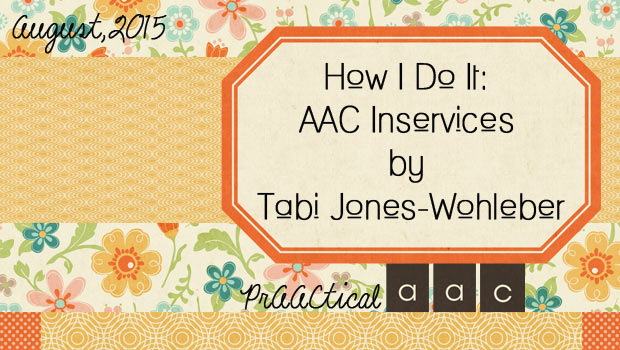
Many SLPs involved in AAC service provision are called upon to provide inservice training on implementation strategies. In this post, we are very fortunate to have Tabi Jones-Wohleber back to share both her thoughts and training materials. Tabi, an SLP on the AT Team for Frederick County Public Schools in Maryland, wrote two previous posts for us. In those posts, Tabi shared her All-in-One Visual Support Tool and Classroom CORE Tool. Today, we hear about her experiences with professional development for teachers, aides, and therapists who serve students with AAC needs. ::::::::::::::::::::::::::::::::::::::::::::::::::::::::: Implementing AAC: A Picture…AND…A Purpose As I work with staff and students to support implementation of AAC, I’ve learned 2 important things about making it work: 1) Folks need to know what it looks like “in their classroom/life” AND 2) effective implementation does not emerge from directives, but rather evolves from understanding, engagement and ownership of the WHAT... [Read More...]
January 29, 2015
by Carole Zangari -
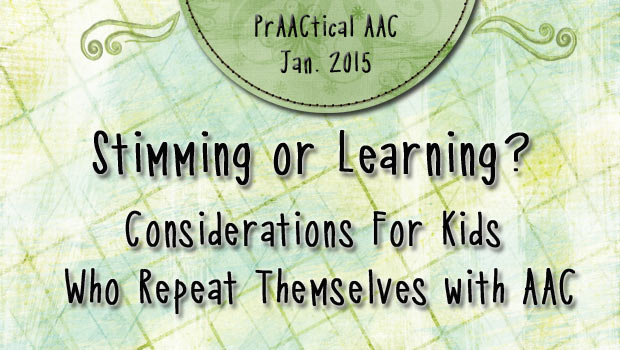
At the CARD 2015 conference earlier this month, I had some great conversations with professionals who wanted to integrate more AAC into their work with beginning communicators. One of the issues that came up was this: What about kids who keep using their AAC to say the same thing over and over? Here are some of the things we discussed. For beginning communicators, repetition is part of exploration. And exploration is part of language learning. Extinguish repetition and we have effectively shut down a tool for language development. Turning off the device, taking it away, or turning the volume controls to silent is NOT an option. (Whew! I can’t tell you how happy I was to hear consensus on that point!) No feeling person would tape the mouth of a speaking child to keep them quiet, and this is the AAC counterpart. Silencing a person by restricting access to their... [Read More...]
July 10, 2014
by Carole Zangari -
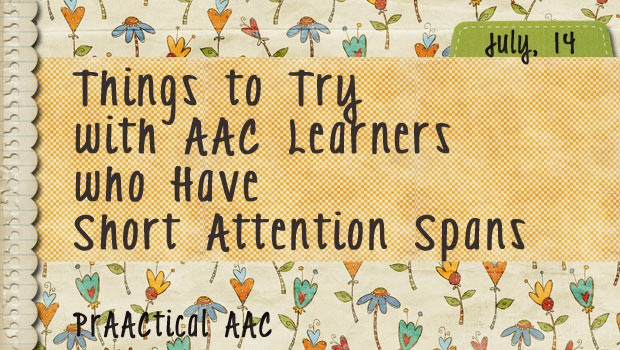
We love talking to AAC practitioners, hearing their stories, and picking up some tips along the way. Some conversations we love for the creative ideas or underlying passion. Others are memorable for less positive reasons. But still, they give us pause and challenge us to be better problem-solvers. “I love those ideas, but they won’t work with MY client: He doesn’t pay attention. He’s just not ready for all this. How do you expect me to teach someone with such a short attention span?” Glad you asked! First, don’t blame the learner. Like having short legs or frizzy hair, attention span is something over which some learners have little or no control. Their physiology is their physiology and they may not like it any more than we do. Use high-interest components in your therapy. The goals are the goals, but we can use things the client likes to make working on... [Read More...]
November 11, 2013
by Robin Parker -
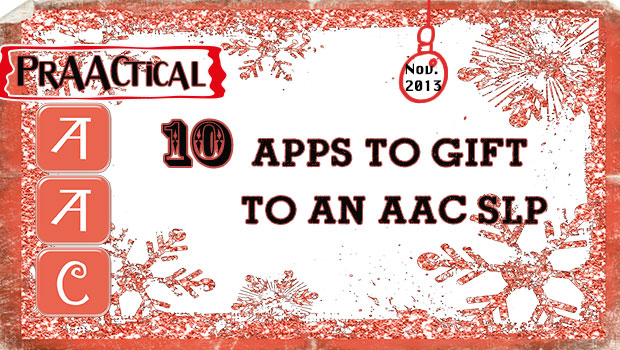
It’s definitely time to think about the holidays because they are almost here. Apps are often a great gift for your colleagues or for the SLP working with your child. Here are just a few suggestions that will help the SLP. Please feel free to share others you think should be added to this list. Evaluation Genie – This app is an informal assessment tool that helps with identifying skill areas that relate specifically to the language representation methods commonly found on augmentative communication systems. There are 14 subtests that help with identifying the features for an AAC device that a student would need. The student responses are recorded and easily reportable. ATEval2Go – designed helps guide you through a template for technology considerations so that the SLP can document observations and information in a structured manner. All the documentation can then generate an editable usable report. Additionally, a goal bank can be... [Read More...]
October 26, 2013
by Robin Parker -
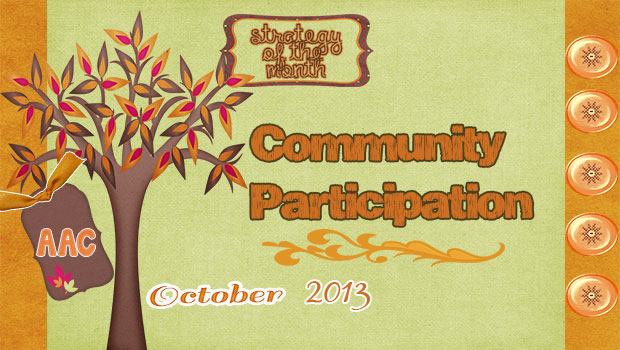
Community participation and communication for AAC users is an integral part of of developing, growing up, and having inclusive opportunities. We often relate community participation to quality of life indicators. Community participation for AAC users begins from the… beginning. Young children can order in restaurants, use picture menus, and have access to many inclusive events. As children grow into adolescents and adults, community participation involves post secondary options, employment, and community living. Perspectives from AAC Users Have communication displays and devices available at ALL times– You need access to a communication system(s) to participate in all situations. Remember to take AAC with you. The sooner the AAC user becomes responsible for taking or telling someone to take the device/displays with them the easier it becomes. For mobile technology systems, there are rugged cases that withstand wind, water, even medical waste (see Lauren Enders Pinterest boards for case and accessory options).... [Read More...]
October 24, 2013
by Robin Parker -

Cooking is a great activity as the platform for meaningful language experiences for both children and adults. Halloween often involves candy and tasty treats. However, there are also plenty of healthy Halloween foods (e.g., carrot pumpkins, tangerine & celery pumpkins, or apple teeth to name just a few). Then comes Thanksgiving and all the recipes that go along with it (e.g., lots of opportunity for repetition with variety). Everyone can be involved with cooking, although just because you cook doesn’t mean you need a stove. From spooky chex mix to more elaborate cookie and cake decorations, there is a ton of active participation and conversation that can be incorporated into cooking. And the fun and rewards (eating) are built-in. Although there are plenty of Halloween recipes, many recipes can be turned ‘spooky’ with an addition/modification of Halloween shapes or colors. You can cook using core words and/or focusing on the... [Read More...]
October 12, 2013
by Robin Parker -
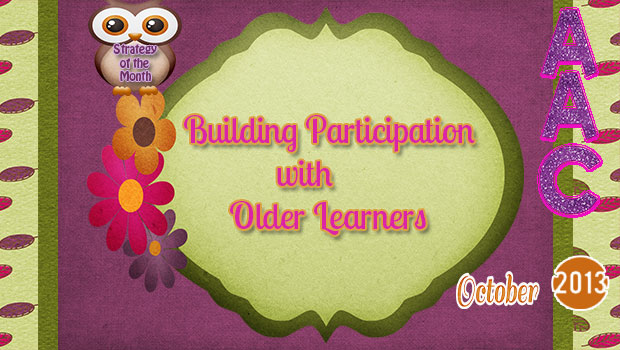
We love active participation for communication and language learning. Actually, we love active participation in all areas of life for us, for our students, for everyone. When Carole introduced the Building Participation Strategy of the Month, she discussed the role of the Participation Model (Beukelman & Mirenda, 1988; 2013). The Participation Model is a framework for understanding the barriers to participation and then from a prAACtical intervention standpoint developing strategies and activities to increase active participation in a variety of (ALL) aspects of life. For the 2012 AAC Awareness Month, we discussed barriers to participation. This year’s focus is on activities and strategies for getting past the barriers to building age appropriate authentic active participation for ALL learners. We have learned that when older learners with significant communication challenges are provided with age appropriate activities and supports, they can be engaged and motivated to participate and can often surprise us with... [Read More...]
October 4, 2013
by Robin Parker -
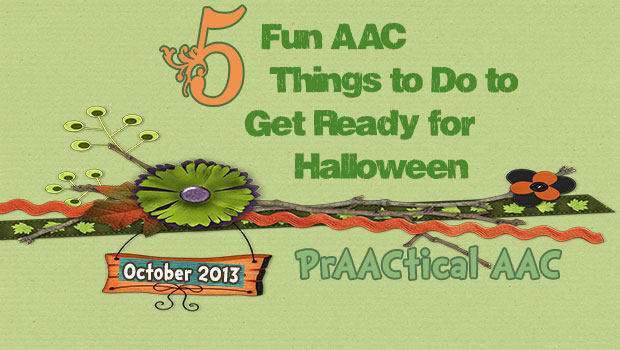
We love to start planning for holidays early. It helps facilitate conversation before, during, & after exciting activities and events. When we begin using core and fringe vocabulary early, frequently, and authentically the learner has the most opportunity for success. Use Schedules: Use a monthly calendar to have a Halloween countdown, Use mini-schedules to make food recipes, spooky science concoctions, or even to plan the trick or treating routes. Use a small talk app like Fat Cat Spooky Chat to prAACtice what you will SAY (October core words) on Halloween. Use a social narrative to prepare everyone for what to expect on and around Halloween. More Halloween social narratives can be found at Autism Community, One Place for Special Needs, Katherine Sanger You Tube, & Kentucky Autism Training Center Prepare a choice board of Halloween costume options and let the learner decide on the costume. PrAACtice a script to be... [Read More...]
September 23, 2013
by Robin Parker -
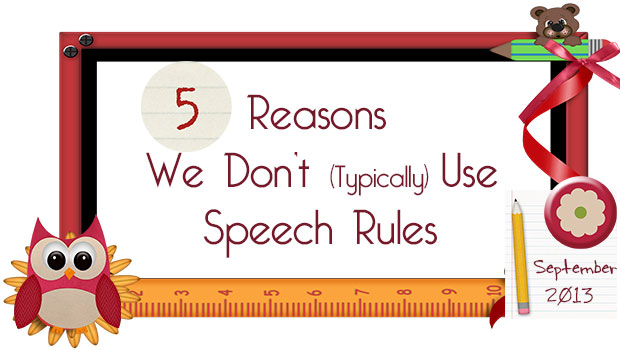
We love organized productive speech therapy sessions. But, we don’t typically use speech rules in our sessions. It’s not that we are inherently against ‘behavior speech rules’ but overall, we don’t use them. Here are some of the reasons why: We use meaningful language activities. We try to use meaningful, fun, and engaging activities so learners want to participate. Even when we think an activity is enjoyable and it is not, it becomes enjoyable and meaningful to “stop” the activity. It is helpful to think about meaningful and fun from the learner’s perspective and not just ours. For example, having a pleasant conversation about awesome pretty pictures would be enjoyable for many students. However, if conversation is difficult, maybe not so much. It’s not that we would not work on conversation, but the activity structure may involve clear beginnings and endings to the conversation, a ‘take home poster’, and/or a... [Read More...]
August 10, 2013
by Robin Parker -
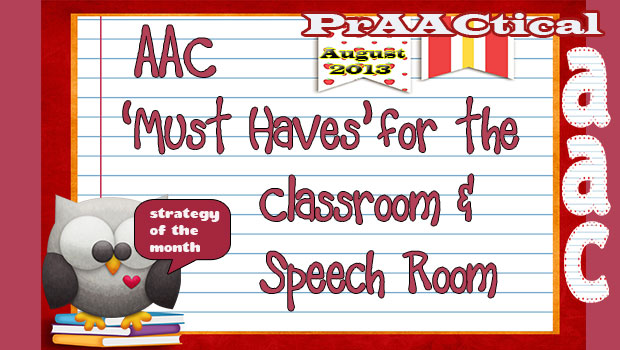
As we were getting ready for back to school and thinking about ‘must haves’, it quickly became apparent that it is not so easy to narrow it down. And the ‘must haves’ would definitely vary depending upon type of class, students, and even school. Based on a wide variety of differences, we organized a wide variety of choices to explore (we apologize in advance if we got carried away but…). Choose what you need, bookmark what you may need later and let us know your ‘must haves’ for a classroom and speech room AAC collaborative approach. We will create an ongoing list. Get Started Before School Starts Do these 10 Things to Get Started with AAC if you are new to an AAC student or classroom Provide AAC Support in the Classroom. Support teachers and educators with tips from Jane Farrall, & learn about AAC in the Classroom by Joan... [Read More...]









